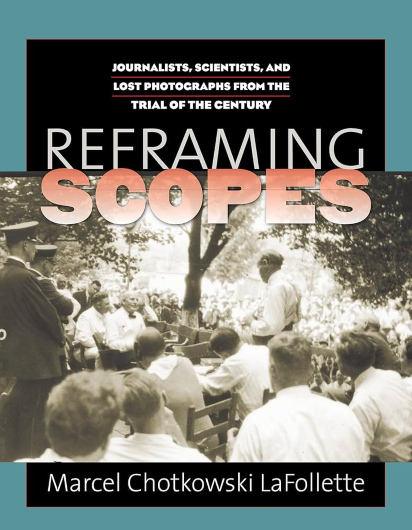How many readers of this journal, if asked to think of images of the Scopes trial, find mental pictures of Spencer Tracy, Fredric Marsh, and other actors from Inherit the Wind? Sure, we know the film and play it was based on was really a McCarthy-era allegory, but the Hollywood image has proven quite sticky indeed. The real Scopes trial, held in Dayton, Tennessee, in the summer of 1925, was carried on WGN radio and covered by colorful print journalists of the era like HL Mencken and Joseph Wood Krutch, and their  word-pictures have proven highly influential. Some contemporary photographs and more editorial cartoons have survived, but for many the real Dayton has been overtaken by the fictional Hillsboro. Now there is a possible cure for this condition.
word-pictures have proven highly influential. Some contemporary photographs and more editorial cartoons have survived, but for many the real Dayton has been overtaken by the fictional Hillsboro. Now there is a possible cure for this condition.
In 2005, eighty years after the trial of high school teacher John Thomas Scopes, historian Marcel Chotkowski LaFollette discovered an amazing collection of photographs in an only partly processed collection at the Smithsonian Institution Archives. In this short volume, she has intelligently blended the restored photographs with pictures from other collections for a total of fifty-one images. Attached to each is an informative caption, and from the assemblage she draws attention to themes and interpretations of the trial lost from view in other accounts. We see the expected cast: defendant Scopes, guest prosecutor William Jennings Bryan, and defense attorney Clarence Darrow. More valuable, perhaps, are the images of the defense team of lawyers, scientist–witnesses, and interested supporters assembled on the steps of their trial headquarters. While most contemporary and historical attention from the trial has centered on the high-profile attorneys arguing the case, LaFollette's pictures and text showcase zoologist Maynard M Metcalf, the only scientist who actually testified on the stand in Dayton; Howard Gale Byrd, a minister of the Methodist Episcopal Church who was forced to resign his pulpit in Dayton in the midst of the church in a controversy surrounding the discussion of evolution in the church; E Haldeman-Julius, an advocate of science and reason who published radical tracts and drove to Dayton from Kansas with his wife Marcet; and an assembly of worshippers gathered for a baptism in a stream nearby during the trial.
Even though they have a certain behind-the-scenes quality, most of the images are clearly posed, but this is not surprising given their source: the bulk of the photographs in the book were snapped by Watson Davis, who in 1925 was in Dayton to cover the trial as a journalist along with Frank Thone, a biologist with a PhD from the University of Chicago and an interest in popularizing science. Without Davis and Thone there would be no book here, and it is their presence and mission in Dayton that provide what is most unique in LaFollette's approach to this much covered media and legal event. Watson was in Dayton as managing editor of the Science Service, an organization endowed by publisher EW Scripps and cooperating with scientists and journalists. Science Service had a difficult mission: to provide the public both interesting and accurate stories of contemporary science and technology. The circus atmosphere of the Scopes trial would provide both a wonderful opportunity for the young organization to demonstrate its utility but also a large challenge to overcome all the sensationalist press issued by partisans on both sides of the affair.
LaFollette is well equipped to investigate and assess the role of Davis, Thone, and the Science Service in the Scopes Trial. In her previous books, she has explored the public images of science in the first half of the twentieth century as well as the history of plagiarism and scholarly misconduct among scientists. She is complimentary of, even thankful for, Davis's and Thone's efforts to document the trial and publicize its scientific issues in the 1920s and in preserving their records for posterity. But she also takes a critical approach to the two scientific journalists' position in the trial: not content to be just observers, the two were active participants in the defense team efforts. Even while distributing stories on the scientific aspects of the trial, they assisted in recruiting scientists to testify for the defense. Their close affiliation with the defense may have given the lie to any quaint notion of journalistic objectivity, but it did allow them to acquire the many great images reprinted in the book. And it led to another of their legacies from the trial: Davis and Thone led the effort to fund defendant John T Scopes's graduate education at the University of Chicago. Impressed by his lack of desire to take the spotlight in the trial or afterword, the two scientist–journalists helped to protect his privacy after the trial.
LaFollette does a fine job of using the pictures to open up many different stories of the trial. Scholars in many fields will be both interested to see what she pulls from the images and frustrated that she did not pursue the themes more. But she intelligently introduces many issues — journalistic objectivity, the religious preferences of the scientists, the objectifying gaze of the journalists on the local holiness religious practices, and the failed aspirations for economic rebirth in Dayton — without getting too far from the images or losing general readers.

